Formation of Transitional cE/UCD Galaxies through Massive/Dwarf Disc Galaxy Mergers
Abstract
:1. Introduction
- —
- Reducing the mass of dwarf elliptical galaxies due to tidal influences may be an important mechanism of the galaxy threshing system [13,19]. The outer layers of a stellar system can be effectively removed due to tidal forces in such large clusters as the Fornax Cluster, the Coma Cluster, the Perseus Cluster, and the Virgo Cluster. The threshing rate is higher for highly eccentric orbits compared to the circular motion of the satellite [19]. The compact dwarf core as the basis of UCDs is preserved under strong tidal influences over cosmological times. This mechanism may be sensitive to the initial dark-halo profile of the dwarf galaxy [19]. UCDs can be born from the core of tidally stripped dwarf elliptical galaxies (dEs) or dE/Ns galaxies with low surface brightness [19,36].
- —
- —
- The authors of the work [40] considered the possibility of forming UCDs from supergiant molecular clouds with masses –. Hydrodynamic simulations produced clusters with parameters that were typical of ultracompact dwarfs.
- —
- As the sizes of small UCDs and large GCs can be comparable within a sequence with a smooth, continuous distribution of parameters, some common mechanisms for the construction of these objects are discussed, which are the extreme high-luminosity end of the mass function or the result of several associations of large globular clusters [25,41].
- —
- The tidal stripping of a barred disc galaxy in a cluster cD galaxy can form a compact remnant [13]. This conclusion is confirmed by N-body simulations of the evolution of a large S-galaxy such as the Milky Way, which moves in a gravitational potential with parameters similar to those of the Virgo cluster.
- —
2. Minor-Merger Model
3. Simulation Results
3.1. General Picture of the Minor Merging Dynamics
3.2. Formation and Characteristics of Transitional cE/UCD
4. Discussion
5. Conclusions
- —
- Approximately half of the initial mass of stars can be used to build a compact stellar core. This fraction decreases with the increasing mass of gas in the satellite. The gas component is an important factor contributing to the stripping of the stellar and dark components when passing through the disc of the main galaxy. A gas-rich dwarf produces a compact core with 2 times less mass and size compared to the same satellite without gas. The final gas content in a compact object is negligible.
- —
- The formation of a quasi-stationary compact core takes 4–9 billion years, depending on the gas content and the initial angle of incidence of the satellite on the disc. The fall of a gas-rich dwarf disc galaxy from a region of low galactic latitudes can create a cE/UCD galaxy in 4–5 billion years from just four or five disc crossings. The fall of a satellite from high galactic latitudes extends the time of formation of a compact elliptical galaxy.
- —
- All the models gave strong stripping of the dark halo of the satellite. As a result, the DM mass decreased by more than an order of magnitude and did not have a noticeable effect on the dynamics of the satellite’s core. Thus, the formed cE/UCD models did not contain significant dark mass at the end of the numerical simulations.
- —
- The constructed models of compact elliptical galaxies differed slightly from the spherical shape, and the ratio of the axes gives the morphological type E0–E2, depending on the initial gas content in the satellite.
- —
- The compact/ultra-compact cores in our numerical models have a mass of (1–5) and an effective radius of = 60–200 pc, and are long-lived. Such objects continue to persist almost unchanged over dozens of orbital periods, despite further numerous crossings of the disc of the main galaxy. The core stellar mass loss per revolution can initially exceed ∼30 percent in gas-rich models and decreases greatly with each new crossing of the main galaxy. The result of one crossing of the disc by the core in the modern era after 9 billion years of evolution is 1–2 percent in the initially gas-rich satellite and 3–6 percent in the gas-free satellite.
- —
- The rotation of stars in stripped nuclei was determined by the initial gas content in the satellite in the considered models. A very gas-rich satellite produces cE/UCD-type objects with almost no rotation. Models without initial gas give noticeable internal rotation of the compact object. It should be noted that different mechanisms for stripping the nucleus of a dwarf galaxy can result in different rates of angular momentum loss. For example, our consideration of interaction with a large spiral galaxy may be very different from merging in a cluster with a cD galaxy.
Author Contributions
Funding
Data Availability Statement
Conflicts of Interest
Abbreviations
| MW | Milky Way |
| GSE | Gaia-Sausage-Enceladus |
| DM | Dark Matter |
| SPH | Smoothed-Particle Hydrodynamics |
| UCDs | Ultracompact Dwarf Galaxies |
| UDGs | Ultra-diffuse galaxies |
| GCs | Globular clusters |
| NSC | Nuclear Star Cluster |
| SC | Satellite Core |
References
- Battaglia, G.; Nipoti, C. Stellar dynamics and dark matter in Local Group dwarf galaxies. Nat. Astron. 2022, 6, 659–672. [Google Scholar] [CrossRef]
- Karachentsev, I.D.; Kaisina, E.I. New Local Volume Dwarf Galaxy Candidates from the DESI Legacy Imaging Surveys. Astrophys. Bull. 2022, 77, 372–387. [Google Scholar] [CrossRef]
- Carlsten, S.G.; Greene, J.E.; Beaton, R.L.; Danieli, S.; Greco, J.P. The Exploration of Local VolumE Satellites (ELVES) Survey: A Nearly Volume-limited Sample of Nearby Dwarf Satellite Systems. Astrophys. J. 2022, 933, 47. [Google Scholar] [CrossRef]
- Karachentsev, I.D.; Makarov, D.I.; Kaisina, E.I. Updated Nearby Galaxy Catalog. Astron. J. 2013, 145, 101. [Google Scholar] [CrossRef]
- Chilingarian, I.; Cayatte, V.; Chemin, L.; Durret, F.; Laganá, T.F.; Adami, C.; Slezak, E. Discovery of a new M 32-like “Compact Elliptical” galaxy in the halo of the Abell 496 cD galaxy. Astron. Astrophys. 2007, 466, L21–L24. [Google Scholar] [CrossRef]
- Chilingarian, I.V.; Prugniel, P.; Sil’chenko, O.K.; Afanasiev, V.L. Kinematics and stellar populations of the dwarf elliptical galaxy IC 3653. Mon. Not. R. Astron. Soc. 2007, 376, 1033–1046. [Google Scholar] [CrossRef]
- McConnachie, A.W. The Observed Properties of Dwarf Galaxies in and around the Local Group. Astron. J. 2012, 144, 4. [Google Scholar] [CrossRef]
- Henkel, C.; Hunt, L.K.; Izotov, Y.I. The Interstellar Medium of Dwarf Galaxies. Galaxies 2022, 10, 11. [Google Scholar] [CrossRef]
- Afanasiev, A.V.; Chilingarian, I.V.; Grishin, K.A.; Makarov, D.; Makarova, L.; Fabricant, D.; Caldwell, N.; Moran, S. KDG 64: A large dwarf spheroidal or a small ultradiffuse satellite of Messier 81. Mon. Not. R. Astron. Soc. 2023, 520, 6312–6321. [Google Scholar] [CrossRef]
- Makarova, L.N.; Makarov, D.I. Spatial segregation impact on star formation in nearby dwarf spheroidal galaxies. Mon. Not. R. Astron. Soc. 2021, 502, 1623–1632. [Google Scholar] [CrossRef]
- Bekki, K.; Couch, W.J.; Drinkwater, M.J.; Gregg, M.D. A New Formation Model for M32: A Threshed Early-Type Spiral Galaxy? Astrophys. J. 2001, 557, L39–L42. [Google Scholar] [CrossRef]
- Deeley, S.; Drinkwater, M.J.; Sweet, S.M.; Bekki, K.; Couch, W.J.; Forbes, D.A. The formation pathways of compact elliptical galaxies. Mon. Not. R. Astron. Soc. 2023, 525, 1192–1209. [Google Scholar] [CrossRef]
- Chilingarian, I.; Cayatte, V.; Revaz, Y.; Dodonov, S.; Durand, D.; Durret, F.; Micol, A.; Slezak, E. A Population of Compact Elliptical Galaxies Detected with the Virtual Observatory. Science 2009, 326, 1379–1382. [Google Scholar] [CrossRef] [PubMed]
- Newton, O.; Di Cintio, A.; Cardona-Barrero, S.; Libeskind, N.I.; Hoffman, Y.; Knebe, A.; Sorce, J.G.; Steinmetz, M.; Tempel, E. The Undiscovered Ultradiffuse Galaxies of the Local Group. Astrophys. J. Lett. 2023, 946, L37. [Google Scholar] [CrossRef]
- Chilingarian, I.V.; Bergond, G. SDSS J150634.27+013331.6: The second compact elliptical galaxy in the NGC 5846 group. Mon. Not. R. Astron. Soc. Lett. 2010, 405, L11–L15. [Google Scholar] [CrossRef]
- Price, J.; Phillipps, S.; Huxor, A.; Trentham, N.; Ferguson, H.C.; Marzke, R.O.; Hornschemeier, A.; Goudfrooij, P.; Hammer, D.; Tully, R.B.; et al. The HST/ACS Coma Cluster Survey–V. Compact stellar systems in the Coma Cluster. Mon. Not. R. Astron. Soc. 2009, 397, 1816–1835. [Google Scholar] [CrossRef]
- Chilingarian, I.; Zolotukhin, I. Isolated compact elliptical galaxies: Stellar systems that ran away. Science 2015, 348, 418–421. [Google Scholar] [CrossRef] [PubMed]
- Evstigneeva, E.A.; Gregg, M.D.; Drinkwater, M.J.; Hilker, M. Internal Properties of Ultracompact Dwarf Galaxies in the Virgo Cluster. Astron. J. 2007, 133, 1722–1740. [Google Scholar] [CrossRef]
- Bekki, K.; Couch, W.J.; Drinkwater, M.J.; Shioya, Y. Galaxy threshing and the origin of ultra-compact dwarf galaxies in the Fornax cluster. Mon. Not. R. Astron. Soc. 2003, 344, 399–411. [Google Scholar] [CrossRef]
- Norris, M.A.; Kannappan, S.J.; Forbes, D.A.; Romanowsky, A.J.; Brodie, J.P.; Faifer, F.R.; Huxor, A.; Maraston, C.; Moffett, A.J.; Penny, S.J.; et al. The AIMSS Project—I. Bridging the star cluster–galaxy divide. Mon. Not. R. Astron. Soc. 2014, 443, 1151–1172. [Google Scholar] [CrossRef]
- Minniti, D.; Kissler-Patig, M.; Goudfrooij, P.; Meylan, G. Radial Velocities of Globular Clusters in the Giant Elliptical Galaxy NGC 1399. Astron. J. 1998, 115, 121–129. [Google Scholar] [CrossRef]
- Hilker, M.; Infante, L.; Vieira, G.; Kissler-Patig, M.; Richtler, T. The central region of the Fornax cluster—II. Spectroscopy and radial velocities of member and background galaxies. Astron. Astrophys. Suppl. Ser. 1999, 134, 75–86. [Google Scholar] [CrossRef]
- Drinkwater, M.J.; Jones, J.B.; Gregg, M.D.; Phillipps, S. Compact Stellar Systems in the Fornax Cluster: Super-massive Star Clusters or Extremely Compact Dwarf Galaxies? Publ. Astron. Soc. Aust. 2000, 17, 227–233. [Google Scholar] [CrossRef]
- Phillipps, S.; Drinkwater, M.J.; Gregg, M.D.; Jones, J.B. Ultracompact Dwarf Galaxies in the Fornax Cluster. Astrophys. J. 2001, 560, 201–206. [Google Scholar] [CrossRef]
- Mieske, S.; Hilker, M.; Infante, L. Ultra compact objects in the Fornax cluster of galaxies: Globular clusters or dwarf galaxies? Astron. Astrophys. 2002, 383, 823–837. [Google Scholar] [CrossRef]
- Drinkwater, M.J.; Gregg, M.D.; Hilker, M.; Bekki, K.; Couch, W.J.; Ferguson, H.C.; Jones, J.B.; Phillipps, S. A class of compact dwarf galaxies from disruptive processes in galaxy clusters. Nature 2003, 423, 519–521. [Google Scholar] [CrossRef]
- Zapata, F.U.; Fellhauer, M.; Jara, A.A.G.; Carrillo, D.R.M.; Aravena, C.A. The formation of compact dwarf ellipticals through merging star clusters. Mon. Not. R. Astron. Soc. 2019, 489, 2746–2754. [Google Scholar] [CrossRef]
- Brüns, R.C.; Kroupa, P.A. A catalog of extended clusters and ultra-compact dwarf galaxies—An analysis of their parameters in early- and late-type galaxies. Astron. Astrophys. 2012, 547, A65. [Google Scholar] [CrossRef]
- Zhang, Y.; Bell, E.F. M32 Analogs? A Population of Massive Ultra-compact Dwarf and Compact Elliptical Galaxies in Intermediate-redshift Clusters. Astrophys. J. Lett. 2017, 835, L2. [Google Scholar] [CrossRef]
- Mieske, S.; Hilker, M.; Jordán, A.; Infante, L.; Kissler-Patig, M.; Rejkuba, M.; Richtler, T.; Côté, P.; Baumgardt, H.; West, M.J.; et al. The nature of UCDs: Internal dynamics from an expanded sample and homogeneous database. Astron. Astrophys. 2008, 487, 921–935. [Google Scholar] [CrossRef]
- Paudel, S.; Duc, P.A.; Lim, S.; Poulain, M.; Marleau, F.R.; Müller, O.; Sánchez-Janssen, R.; Habas, R.; Durrell, P.R.; Heesters, N.; et al. The creation of a massive UCD by tidal threshing from NGC 936. Mon. Not. R. Astron. Soc. Lett. 2023, 526, L136–L142. [Google Scholar] [CrossRef]
- Penny, S.J.; Forbes, D.A.; Strader, J.; Usher, C.; Brodie, J.P.; Romanowsky, A.J. Ultracompact dwarfs in the Perseus Cluster: UCD formation via tidal stripping. Mon. Not. R. Astron. Soc. 2014, 439, 3808–3816. [Google Scholar] [CrossRef]
- Chilingarian, I.V.; Mieske, S.; Hilker, M.; Infante, L. Dynamical versus stellar masses of ultracompact dwarf galaxies in the Fornax cluster. Mon. Not. R. Astron. Soc. 2011, 412, 1627–1638. [Google Scholar] [CrossRef]
- Karachentsev, I.D.; Karachentseva, V.E.; Huchtmeier, W.K.; Makarov, D.I. A Catalog of Neighboring Galaxies. Astron. J. 2004, 127, 2031–2068. [Google Scholar] [CrossRef]
- Schweizer, F.; Seitzer, P.; Whitmore, B.C.; Kelson, D.D.; Villanueva, E.V. The Second Nucleus of NGC 7727: Direct Evidence for the Formation and Evolution of an Ultracompact Dwarf Galaxy. Astrophys. J. 2018, 853, 26. [Google Scholar] [CrossRef]
- Chilingarian, I.V.; Cayatte, V.; Bergond, G. Stellar population constraints on the dark matter content and origin of ultra-compact dwarf galaxies. Mon. Not. R. Astron. Soc. 2008, 390, 906–912. [Google Scholar] [CrossRef]
- Mayes, R.J.; Drinkwater, M.J.; Pfeffer, J.; Baumgardt, H.; Liu, C.; Ferrarese, L.; Côté, P.; Peng, E.W. Testing the tidal stripping scenario of ultracompact dwarf galaxy formation by using internal properties. Mon. Not. R. Astron. Soc. 2021, 506, 2459–2470. [Google Scholar] [CrossRef]
- Fellhauer, M.; Kroupa, P. A possible formation scenario for the ultramassive cluster W3 in NGC 7252. Mon. Not. R. Astron. Soc. 2005, 359, 223–227. [Google Scholar] [CrossRef]
- Kissler-Patig, M.; Jordán, A.; Bastian, N. The transition between star clusters and dwarf galaxies. Astron. Astrophys. 2006, 448, 1031–1035. [Google Scholar] [CrossRef]
- Goodman, M.; Bekki, K. Formation of ultra-compact dwarf galaxies from supergiant molecular clouds. Mon. Not. R. Astron. Soc. 2018, 478, 3564–3575. [Google Scholar] [CrossRef]
- Bekki, K.; Forbes, D.A.; Beasley, M.A.; Couch, W.J. Globular cluster formation from gravitational tidal effects of merging and interacting galaxies. Mon. Not. R. Astron. Soc. 2002, 335, 1176–1192. [Google Scholar] [CrossRef]
- Chilingarian, I.V.; Mamon, G.A. SDSS J124155.33+114003.7—A missing link between compact elliptical and ultracompact dwarf galaxies. Mon. Not. R. Astron. Soc. Lett. 2008, 385, L83–L87. [Google Scholar] [CrossRef]
- Makarova, L.N.; Tully, R.B.; Anand, G.S.; Lambert, T.S.; Sharina, M.E.; Koribalski, B.S.; Kraan-Korteweg, R.C. A Nearby Isolated Dwarf: Star Formation and Structure of ESO 006–001. Astrophys. J. 2023, 943, 139. [Google Scholar] [CrossRef]
- Ferré-Mateu, A.; Durré, M.; Forbes, D.A.; Romanowsky, A.J.; Alabi, A.; Brodie, J.P.; McDermid, R.M. Low-mass compact elliptical galaxies: Spatially resolved stellar populations and kinematics with the Keck Cosmic Web Imager. Mon. Not. R. Astron. Soc. 2021, 503, 5455–5472. [Google Scholar] [CrossRef]
- Ferré-Mateu, A.; Mezcua, M.; Barrows, R.S. A search for active galactic nuclei in low-mass compact galaxies. Mon. Not. R. Astron. Soc. 2021, 506, 4702–4714. [Google Scholar] [CrossRef]
- Seth, A.C.; van den Bosch, R.; Mieske, S.; Baumgardt, H.; Brok, M.D.; Strader, J.; Neumayer, N.; Chilingarian, I.; Hilker, M.; McDermid, R.; et al. A supermassive black hole in an ultra-compact dwarf galaxy. Natrue 2014, 513, 398–400. [Google Scholar] [CrossRef]
- Ahn, C.P.; Seth, A.C.; den Brok, M.; Strader, J.; Baumgardt, H.; van den Bosch, R.; Chilingarian, I.; Frank, M.; Hilker, M.; McDermid, R.; et al. Detection of Supermassive Black Holes in Two Virgo Ultracompact Dwarf Galaxies. Astrophys. J. 2017, 839, 72. [Google Scholar] [CrossRef]
- Pechetti, R.; Seth, A.; Cappellari, M.; McDermid, R.; den Brok, M.; Mieske, S.; Strader, J. Detection of Enhanced Central Mass-to-light Ratios in Low-mass Early-type Galaxies: Evidence for Black Holes? Astrophys. J. 2017, 850, 15. [Google Scholar] [CrossRef]
- Afanasiev, A.V.; Chilingarian, I.V.; Mieske, S.; Voggel, K.T.; Picotti, A.; Hilker, M.; Seth, A.; Neumayer, N.; Frank, M.; Romanowsky, A.J.; et al. A 3.5 million Solar masses black hole in the centre of the ultracompact dwarf galaxy fornax UCD3. Mon. Not. R. Astron. Soc. 2018, 477, 4856–4865. [Google Scholar] [CrossRef]
- Ahn, C.P.; Seth, A.C.; Cappellari, M.; Krajnović, D.; Strader, J.; Voggel, K.T.; Walsh, J.L.; Bahramian, A.; Baumgardt, H.; Brodie, J.; et al. The Black Hole in the Most Massive Ultracompact Dwarf Galaxy M59-UCD3. Astrophys. J. 2018, 858, 102. [Google Scholar] [CrossRef]
- Voggel, K.T.; Seth, A.C.; Baumgardt, H.; Mieske, S.; Pfeffer, J.; Rasskazov, A. The Impact of Stripped Nuclei on the Supermassive Black Hole Number Density in the Local Universe. Astrophys. J. 2019, 871, 159. [Google Scholar] [CrossRef]
- Mayes, R.; Drinkwater, M.; Pfeffer, J.; Baumgardt, H. Supermassive black holes in UCDs formed from the nuclei of disrupted galaxies. arXiv 2023, arXiv:2302.08082. [Google Scholar] [CrossRef]
- Vasiliev, E. The Effect of the LMC on the Milky Way System. Galaxies 2023, 11, 59. [Google Scholar] [CrossRef]
- Grion Filho, D.; Johnston, K.V.; Poggio, E.; Laporte, C.F.P.; Drimmel, R.; D’Onghia, E. A holistic review of a galactic interaction. Mon. Not. R. Astron. Soc. 2021, 507, 2825–2842. [Google Scholar] [CrossRef]
- Tanaka, M.; Koike, M.; Naito, S.; Shibata, J.; Usuda-Sato, K.; Yamaoka, H.; Ando, M.; Ito, K.; Kobayashi, U.; Kofuji, Y.; et al. Galaxy Cruise: Deep Insights into Interacting Galaxies in the Local Universe. Publ. Astron. Soc. Jpn. 2023, 75, 986–1010. [Google Scholar] [CrossRef]
- O’Ryan, D.; Merín, B.; Simmons, B.D.; Vojteková, A.; Anku, A.; Walmsley, M.; Garland, I.L.; Géron, T.; Keel, W.; Kruk, S.; et al. Harnessing the Hubble Space Telescope Archives: A Catalog of 21,926 Interacting Galaxies. Astrophys. J. 2023, 948, 40. [Google Scholar] [CrossRef]
- Proshina, I.S.; Moiseev, A.V.; Sil’chenko, O.K. Young Star-Forming Complexes in the Ring of the S0 Galaxy NGC 4324. Astron. Lett. 2022, 48, 139–152. [Google Scholar] [CrossRef]
- Martínez-Delgado, D.; Cooper, A.P.; Román, J.; Pillepich, A.; Erkal, D.; Pearson, S.; Moustakas, J.; Laporte, C.F.P.; Laine, S.; Akhlaghi, M.; et al. Hidden depths in the local Universe: The Stellar Stream Legacy Survey. Astron. Astrophys. 2023, 671, A141. [Google Scholar] [CrossRef]
- Nibauer, J.; Bonaca, A.; Johnston, K.V. Constraining the Gravitational Potential from the Projected Morphology of Extragalactic Tidal Streams. Astrophys. J. 2023, 954, 195. [Google Scholar] [CrossRef]
- Tkachenko, R.; Korchagin, V.; Jmailova, A.; Carraro, G.; Jmailov, B. The Influence of the Galactic Bar on the Dynamics of Globular Clusters. Galaxies 2023, 11, 26. [Google Scholar] [CrossRef]
- Block, D.L.; Bournaud, F.; Combes, F.; Groess, R.; Barmby, P.; Ashby, M.L.N.; Fazio, G.G.; Pahre, M.A.; Willner, S.P. An almost head-on collision as the origin of two off-centre rings in the Andromeda galaxy. Nature 2006, 443, 832–834. [Google Scholar] [CrossRef] [PubMed]
- Katkov, I.Y.; Kniazev, A.Y.; Sil’chenko, O.K.; Gasymov, D. Star formation in outer rings of S0 galaxies—IV. NGC 254: A double-ringed S0 with gas counter-rotation. Astron. Astrophys. 2022, 658, A154. [Google Scholar] [CrossRef]
- Zasov, A.V.; Saburova, A.S.; Khoperskov, A.V.; Khoperskov, S.A. Dark matter in galaxies. Physics-Uspekhi (Adv. Phys. Sci.) 2017, 60, 3–39. [Google Scholar] [CrossRef]
- Boselli, A.; Fossati, M.; Longobardi, A.; Kianfar, K.; Dametto, N.Z.; Amram, P.; Anderson, J.P.; Andreani, P.; Boissier, S.; Boquien, M.; et al. A Virgo Environmental Survey Tracing Ionised Gas Emission (VESTIGE)—XII. Ionised gas emission in the inner regions of lenticular galaxies. Astron. Astrophys. 2022, 659, A46. [Google Scholar] [CrossRef]
- Schweizer, F.; Seitzer, P. Remnant of a “Wet” Merger: NGC 34 and Its Young Massive Clusters, Young Stellar Disk, and Strong Gaseous Outflow. Astron. J. 2007, 133, 2132–2155. [Google Scholar] [CrossRef]
- Bastian, N.; Schweizer, F.; Goudfrooij, P.; Larsen, S.S.; Kissler-Patig, M. Luminosity profiles and sizes of massive star clusters in NGC 7252. Mon. Not. R. Astron. Soc. 2013, 431, 1252–1263. [Google Scholar] [CrossRef]
- Albareti, F.D.; Allende Prieto, C.; Almeida, A.; Anders, F.; Anderson, S.; Andrews, B.H.; Aragón-Salamanca, A.; Argudo-Fernández, M.; Armengaud, E.; Aubourg, E.; et al. The 13th Data Release of the Sloan Digital Sky Survey: First Spectroscopic Data from the SDSS-IV Survey Mapping Nearby Galaxies at Apache Point Observatory. Astrophys. J. Suppl. Ser. 2017, 233, 25. [Google Scholar] [CrossRef]
- Collaboration, G.; Prusti, T.; de Bruijne, J.H.J.; Brown, A.G.A.; Vallenari, A.; Babusiaux, C.; Bailer-Jones, C.A.L.; Bastian, U.; Biermann, M.; Evans, D.W.; et al. The Gaia mission. Astron. Astrophys. 2016, 595, A1. [Google Scholar] [CrossRef]
- Vallenari, A.; Brown, A.G.A.; Prusti, T.; de Bruijne, J.H.J.; Arenou, F.; Babusiaux, C.; Biermann, M.; Creevey, O.L.; Ducourant, C.e.a. Gaia Data Release 3. Astron. Astrophys. 2023, 674, A1. [Google Scholar] [CrossRef]
- Yanny, B.; Rockosi, C.; Newberg, H.J.; Knapp, G.R.; Adelman-McCarthy, J.K.; Alcorn, B.; Allam, S.; Allende Prieto, C.; An, D.; Anderson, K.S.J.; et al. SEGUE: A Spectroscopic Survey of 240,000 Stars with g = 14–20. Astron. J. 2009, 137, 4377–4399. [Google Scholar] [CrossRef]
- Majewski, S.R.; Schiavon, R.P.; Frinchaboy, P.M.; Allende Prieto, C.; Barkhouser, R.; Bizyaev, D.; Blank, B.; Brunner, S.; Burton, A.; Carrera, R.; et al. The Apache Point Observatory Galactic Evolution Experiment (APOGEE). Astron. J. 2017, 154, 94. [Google Scholar] [CrossRef]
- Imig, J.; Price, C.; Holtzman, J.A.; Stone-Martinez, A.; Majewski, S.R.; Weinberg, D.H.; Johnson, J.A.; Prieto, C.A.; Beaton, R.L.; Beers, T.C.; et al. A Tale of Two Disks: Mapping the Milky Way with the Final Data Release of APOGEE. Astrophys. J. 2023, 954, 30. [Google Scholar] [CrossRef]
- Belokurov, V.; Erkal, D.; Evans, N.W.; Koposov, S.E.; Deason, A.J. Co-formation of the disc and the stellar halo. Mon. Not. R. Astron. Soc. 2018, 478, 611–619. [Google Scholar] [CrossRef]
- Haywood, M.; Di Matteo, P.; Lehnert, M.D.; Snaith, O.; Khoperskov, S.; Gómez, A. In Disguise or Out of Reach: First Clues about In Situ and Accreted Stars in the Stellar Halo of the Milky Way from Gaia DR2. Astrophys. J. 2018, 863, 113. [Google Scholar] [CrossRef]
- Evans, T.A.; Fattahi, A.; Deason, A.J.; Frenk, C.S. How unusual is the Milky Way’s assembly history? Mon. Not. R. Astron. Soc. 2020, 497, 4311–4321. [Google Scholar] [CrossRef]
- Iorio, G.; Belokurov, V. The shape of the Galactic halo with Gaia DR2 RR Lyrae. Anatomy of an ancient major merger. Mon. Not. R. Astron. Soc. 2018, 482, 3868–3879. [Google Scholar] [CrossRef]
- Helmi, A.; Babusiaux, C.; Koppelman, H.H.; Massari, D.; Veljanoski, J.; Brown, A.G.A. The merger that led to the formation of the Milky Way’s inner stellar halo and thick disk. Nature 2018, 563, 85–88. [Google Scholar] [CrossRef] [PubMed]
- Lane, J.M.M.; Bovy, J.; Mackereth, J.T. The stellar mass of the Gaia-Sausage/Enceladus accretion remnant. Mon. Not. R. Astron. Soc. 2023, 526, 1209–1234. [Google Scholar] [CrossRef]
- García-Bethencourt, G.; Brook, C.B.; Grand, R.J.J.; Kawata, D. A high fidelity Milky Way simulation with Kraken, Gaia-Enceladus, and Sequoia analogues: Clues to their accretion histories. Mon. Not. R. Astron. Soc. 2023, 526, 1190–1197. [Google Scholar] [CrossRef]
- Belokurov, V.; Kravtsov, A. From dawn till disc: Milky Way’s turbulent youth revealed by the APOGEE+Gaia data. Mon. Not. R. Astron. Soc. 2022, 514, 689–714. [Google Scholar] [CrossRef]
- Khoperskov, S.; Minchev, I.; Libeskind, N.; Haywood, M.; Di Matteo, P.; Belokurov, V.; Steinmetz, M.; Gomez, F.A.; Grand, R.J.J.; Hoffman, Y.; et al. The stellar halo in Local Group Hestia simulations—II. The accreted component. Astron. Astrophys. 2023, 677, A90. [Google Scholar] [CrossRef]
- Rey, M.P.; Agertz, O.; Starkenburg, T.K.; Renaud, F.; Joshi, G.D.; Pontzen, A.; Martin, N.F.; Feuillet, D.K.; Read, J.I. VINTERGATAN-GM: The cosmological imprints of early mergers on Milky-Way-mass galaxies. Mon. Not. R. Astron. Soc. 2023, 521, 995–1012. [Google Scholar] [CrossRef]
- Amarante, J.A.S.; Debattista, V.P.; Beraldo, E. Silva, L.; Laporte, C.F.P.; Deg, N. Gastro Library. I. The Simulated Chemodynamical Properties of Several Gaia—Sausage—Enceladus-like Stellar Halos. Astrophys. J. 2022, 937, 12. [Google Scholar] [CrossRef]
- Dillamore, A.M.; Belokurov, V.; Evans, N.W.; Davies, E.Y. Stellar halo substructure generated by bar resonances. Mon. Not. R. Astron. Soc. 2023, 524, 3596–3608. [Google Scholar] [CrossRef]
- Davies, E.Y.; Dillamore, A.M.; Belokurov, V.; Evans, N.W. Stellar halo striations from assumptions of axisymmetry. Mon. Not. R. Astron. Soc. 2023, 524, 3821–3833. [Google Scholar] [CrossRef]
- Belokurov, V.; Vasiliev, E.; Deason, A.J.; Koposov, S.E.; Fattahi, A.; Dillamore, A.M.; Davies, E.Y.; Grand, R.J.J. Energy wrinkles and phase-space folds of the last major merger. Mon. Not. R. Astron. Soc. 2023, 518, 6200–6215. [Google Scholar] [CrossRef]
- Khoperskov, S.; Minchev, I.; Libeskind, N.; Belokurov, V.; Steinmetz, M.; Gomez, F.A.; Grand, R.J.J.; Hoffman, Y.; Knebe, A.; Sorce, J.G.; et al. The stellar halo in Local Group Hestia simulations—III. Chemical abundance relations for accreted and in situ stars. Astron. Astrophys. 2023, 677, A91. [Google Scholar] [CrossRef]
- Naidu, R.P.; Conroy, C.; Bonaca, A.; Zaritsky, D.; Weinberger, R.; Ting, Y.S.; Caldwell, N.; Tacchella, S.; Han, J.J.; Speagle, J.S.; et al. Reconstructing the Last Major Merger of the Milky Way with the H3 Survey. Astrophys. J. 2021, 923, 92. [Google Scholar] [CrossRef]
- Limberg, G.; Souza, S.O.; Pérez-Villegas, A.; Rossi, S.; Perottoni, H.D.; Santucci, R.M. Reconstructing the Disrupted Dwarf Galaxy Gaia-Sausage/Enceladus Using Its Stars and Globular Clusters. Astrophys. J. 2022, 935, 109. [Google Scholar] [CrossRef]
- Vincenzo, F.; Spitoni, E.; Calura, F.; Matteucci, F.; Silva Aguirre, V.; Miglio, A.; Cescutti, G. The Fall of a Giant. Chemical evolution of Enceladus, alias the Gaia Sausage. Mon. Not. R. Astron. Soc. Lett. 2019, 487, L47–L52. [Google Scholar] [CrossRef]
- Feuillet, D.K.; Feltzing, S.; Sahlholdt, C.L.; Casagrande, L. The SkyMapper-Gaia RVS view of the Gaia-Enceladus-Sausage—An investigation of the metallicity and mass of the Milky Way’s last major merger. Mon. Not. R. Astron. Soc. 2020, 497, 109–124. [Google Scholar] [CrossRef]
- Myeong, G.C.; Vasiliev, E.; Iorio, G.; Evans, N.W.; Belokurov, V. Evidence for two early accretion events that built the Milky Way stellar halo. Mon. Not. R. Astron. Soc. 2019, 488, 1235–1247. [Google Scholar] [CrossRef]
- Khrapov, S.; Khoperskov, A.; Korchagin, V. Modeling of Spiral Structure in a Multi-Component Milky Way-Like Galaxy. Galaxies 2021, 9, 29. [Google Scholar] [CrossRef]
- Titov, A.V.; Khoperskov, A.V. Numerical Modeling of the Collisions of Spheroidal Galaxies: Mass Loss Efficiency by Baryon Components. Vestn. St. Petersburg Univ. Math. 2022, 55, 124–134. [Google Scholar] [CrossRef]
- Khrapov, S.S.; Khoperskov, A.V.; Korchagin, V.I. Numerical Modelling of the Dynamics of the Galactic Halos in the Colliding Galaxies. Bull. South Ural. State Univ.-Ser.-Math. Model. Program. Comput. Softw. 2019, 12, 123–135. [Google Scholar] [CrossRef]
- Khoperskov, S.; Zinchenko, I.; Avramov, B.; Khrapov, S.; Berczik, P.; Saburova, A.; Ishchenko, M.; Khoperskov, A.; Pulsoni, C.; Venichenko, Y.; et al. Extreme kinematic misalignment in IllustrisTNG galaxies: The origin, structure, and internal dynamics of galaxies with a large-scale counterrotation. Mon. Not. R. Astron. Soc. 2021, 500, 3870–3888. [Google Scholar] [CrossRef]
- Khrapov, S.; Khoperskov, A. Smoothed-particle hydrodynamics models: Implementation features on GPUs. Commun. Comput. Inf. Sci. 2017, 793, 266–277. [Google Scholar] [CrossRef]
- Khoperskov, S.A.; Vasiliev, E.O.; Sobolev, A.M.; Khoperskov, A.V. The simulation of molecular clouds formation in the Milky Way. Mon. Not. R. Astron. Soc. 2013, 428, 2311–2320. [Google Scholar] [CrossRef]
- Khoperskov, S.; Haywood, M.; Snaith, O.; Di Matteo, P.; Lehnert, M.; Vasiliev, E.; Naroenkov, S.; Berczik, P. Bimodality of [α Fe]–[Fe/H] distributions is a natural outcome of dissipative collapse and disc growth in Milky Way-type galaxies. Mon. Not. R. Astron. Soc. 2021, 501, 5176–5196. [Google Scholar] [CrossRef]
- Monaghan, J.J.; Lattanzio, J.C. A Simulation of the Collapse and Fragmentation of Cooling Molecular Clouds. Astrophys. J. 1991, 375, 177–189. [Google Scholar] [CrossRef]
- Vasiliev, E.O. Non-equilibrium ionization states and cooling rates of photoionized enriched gas. Mon. Not. R. Astron. Soc. 2011, 414, 3145–3157. [Google Scholar] [CrossRef]
- Crain, R.A.; van de Voort, F. Hydrodynamical Simulations of the Galaxy Population: Enduring Successes and Outstanding Challenges. Annu. Rev. Astron. Astrophys. 2023, 61, 473–515. [Google Scholar] [CrossRef]
- Deason, A.J.; Belokurov, V.; Koposov, S.E.; Lancaster, L. Apocenter Pile-up: Origin of the Stellar Halo Density Break. Astrophys. J. Lett. 2018, 862, L1. [Google Scholar] [CrossRef]
- Grand, R.J.J.; Kawata, D.; Belokurov, V.; Deason, A.J.; Fattahi, A.; Fragkoudi, F.; Gimez, F.A.; Marinacci, F.; Pakmor, R. The dual origin of the Galactic thick disc and halo from the gas-rich Gaia-Enceladus Sausage merger. Mon. Not. R. Astron. Soc. 2020, 497, 1603–1618. [Google Scholar] [CrossRef]
- Koppelman, H.; Helmi, A.; Veljanoski, J. One Large Blob and Many Streams Frosting the nearby Stellar Halo in Gaia DR2. Astrophys. J. Lett. 2018, 860, L11. [Google Scholar] [CrossRef]
- Myeong, G.C.; Evans, N.W.; Belokurov, V.; Sanders, J.L.; Koposov, S.E. The Sausage Globular Clusters. Astrophys. J. Lett. 2018, 863, L28. [Google Scholar] [CrossRef]
- Kruijssen, J.M.D.; Pfeffer, J.L.; Reina-Campos, M.; Crain, R.A.; Bastian, N. The formation and assembly history of the Milky Way revealed by its globular cluster population. Mon. Not. R. Astron. Soc. 2019, 486, 3180–3202. [Google Scholar] [CrossRef]
- Torrealba, G.; Belokurov, V.; Koposov, S.E.; Li, T.S.; Walker, M.G.; Sanders, J.L.; Geringer-Sameth, A.; Zucker, D.B.; Kuehn, K.; Evans, N.W.; et al. The hidden giant: Discovery of an enormous Galactic dwarf satellite in Gaia DR2. Mon. Not. R. Astron. Soc. 2019, 488, 2743–2766. [Google Scholar] [CrossRef]
- Boecker, A.; Neumayer, N.; Pillepich, A.; Frankel, N.; Ramesh, R.; Leaman, R.; Hernquist, L. The origin of stars in the inner 500 parsecs in TNG50 galaxies. Mon. Not. R. Astron. Soc. 2023, 519, 5202–5235. [Google Scholar] [CrossRef]
- Hoyer, N.; Neumayer, N.; Seth, A.C.; Georgiev, I.Y.; Greene, J.E. Photometric and structural parameters of newly discovered nuclear star clusters in Local Volume galaxies. Mon. Not. R. Astron. Soc. 2023, 520, 4664–4682. [Google Scholar] [CrossRef]
- Khoperskov, A.V.; Khoperskov, S.A.; Zasov, A.V.; Bizyaev, D.V.; Khrapov, S.S. Interaction between collisionless galactic discs and non-axisymmetric dark matter haloes. Mon. Not. R. Astron. Soc. 2013, 431, 1230–1239. [Google Scholar] [CrossRef]
- Butenko, M.A.; Belikova, I.V.; Kuzmin, N.M.; Khokhlova, S.S.; Ivanchenko, G.S.; Ten, A.V.; Kudina, I.G. Numerical simulation of the galaxies outer spiral structure: The influence of the dark halo non-axisymmetry on the gaseous disk shape. Math. Phys. Comput. Simul. 2022, 25, 73–83. [Google Scholar] [CrossRef]
- Navarro, J.F.; Frenk, C.S.; White, S.D.M. The Structure of Cold Dark Matter Halos. Astrophys. J. 1996, 462, 563–575. [Google Scholar] [CrossRef]
- Zasov, A.V.; Khoperskov, A.V.; Zaitseva, N.A.; Khrapov, S.S. On the Formation of Spiral Arms in Dwarf Galaxies. Astron. Rep. 2021, 65, 1215–1232. [Google Scholar] [CrossRef]
- Anders, F.; Khalatyan, A.; Chiappini, C.; Queiroz, A.B.; Santiago, B.X.; Jordi, C.; Girardi, L.; Brown, A.G.A.; Matijevic, G.; Monari, G.; et al. Photo-astrometric distances, extinctions, and astrophysical parameters for Gaia DR2 stars brighter than G = 18. Astron. Astrophys. 2019, 628, A94. [Google Scholar] [CrossRef]
- Ge, X.; Gu, Q.S.; García-Benito, R.; Lu, S.Y.; Lei, C.L.; Ding, N. Observations of cold gas and star formation in dwarf S0 galaxies. Mon. Not. R. Astron. Soc. 2021, 507, 4262–4273. [Google Scholar] [CrossRef]
- Vieira, K.; Korchagin, V.; Carraro, G.; Lutsenko, A. Vertical Structure of the Milky Way Disk with Gaia DR3. Galaxies 2023, 11, 77. [Google Scholar] [CrossRef]
- Belokurov, V.; Zucker, D.B.; Evans, N.W.; Gilmore, G.; Vidrih, S.; Bramich, D.M.; Newberg, H.J.; Wyse, R.F.G.; Irwin, M.J.; Fellhauer, M.; et al. The Field of Streams: Sagittarius and Its Siblings. Astrophys. J. 2006, 642, L137–L140. [Google Scholar] [CrossRef]
- Cunningham, E.C.; Sanderson, R.E.; Johnston, K.V.; Panithanpaisal, N.; Ness, M.K.; Wetzel, A.; Loebman, S.R.; Escala, I.; Horta, D.; Faucher-Giguère, C.A. Reading the CARDs: The Imprint of Accretion History in the Chemical Abundances of the Milky Way’s Stellar Halo. Astrophys. J. 2022, 934, 172. [Google Scholar] [CrossRef]
- Bassino, L.P.; Muzzio, J.C.; Rabolli, M. Are Globular Clusters the Nuclei of Cannibalized Dwarf Galaxies? Astrophys. J. 1994, 431, 634–639. [Google Scholar] [CrossRef]
- Akins, H.B.; Christensen, C.R.; Brooks, A.M.; Munshi, F.; Applebaum, E.; Engelhardt, A.; Chamberland, L. Quenching Timescales of Dwarf Satellites around Milky Way-mass Hosts. Astrophys. J. 2021, 909, 139. [Google Scholar] [CrossRef]
- Ramatsoku, M.; Serra, P.; Poggianti, B.M.; Moretti, A.; Gullieuszik, M.; Bettoni, D.; Deb, T.; Fritz, J.; van Gorkom, J.H.; Jaffé, Y.L.; et al. GASP—XVII. H I imaging of the jellyfish galaxy JO206: Gas stripping and enhanced star formation. Mon. Not. R. Astron. Soc. 2019, 487, 4580–4591. [Google Scholar] [CrossRef]
- Zasov, A.V.; Saburova, A.S.; Egorov, O.V.; Moiseev, A.V. NGC 90: A hidden jellyfish galaxy? Mon. Not. R. Astron. Soc. 2020, 498, 101–109. [Google Scholar] [CrossRef]

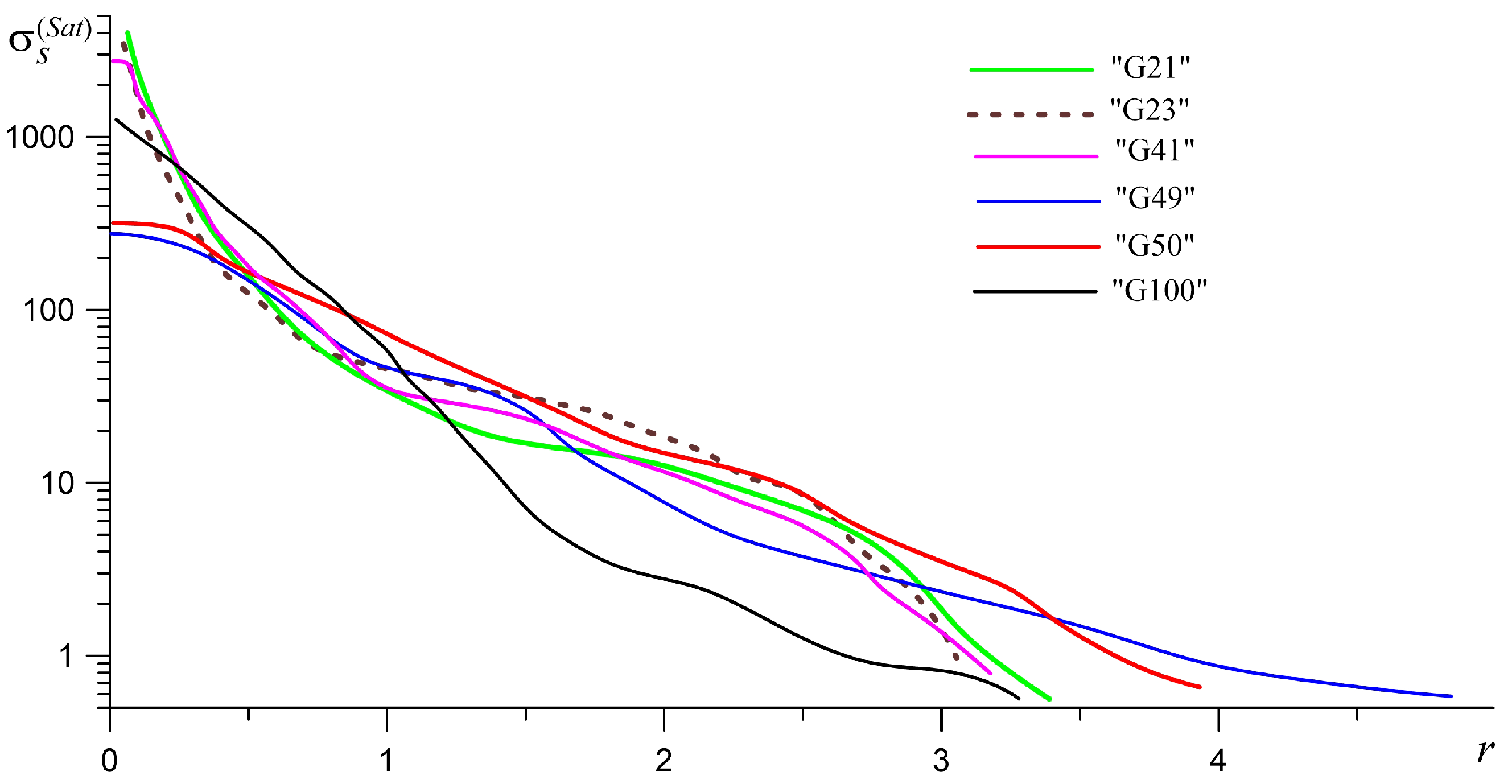
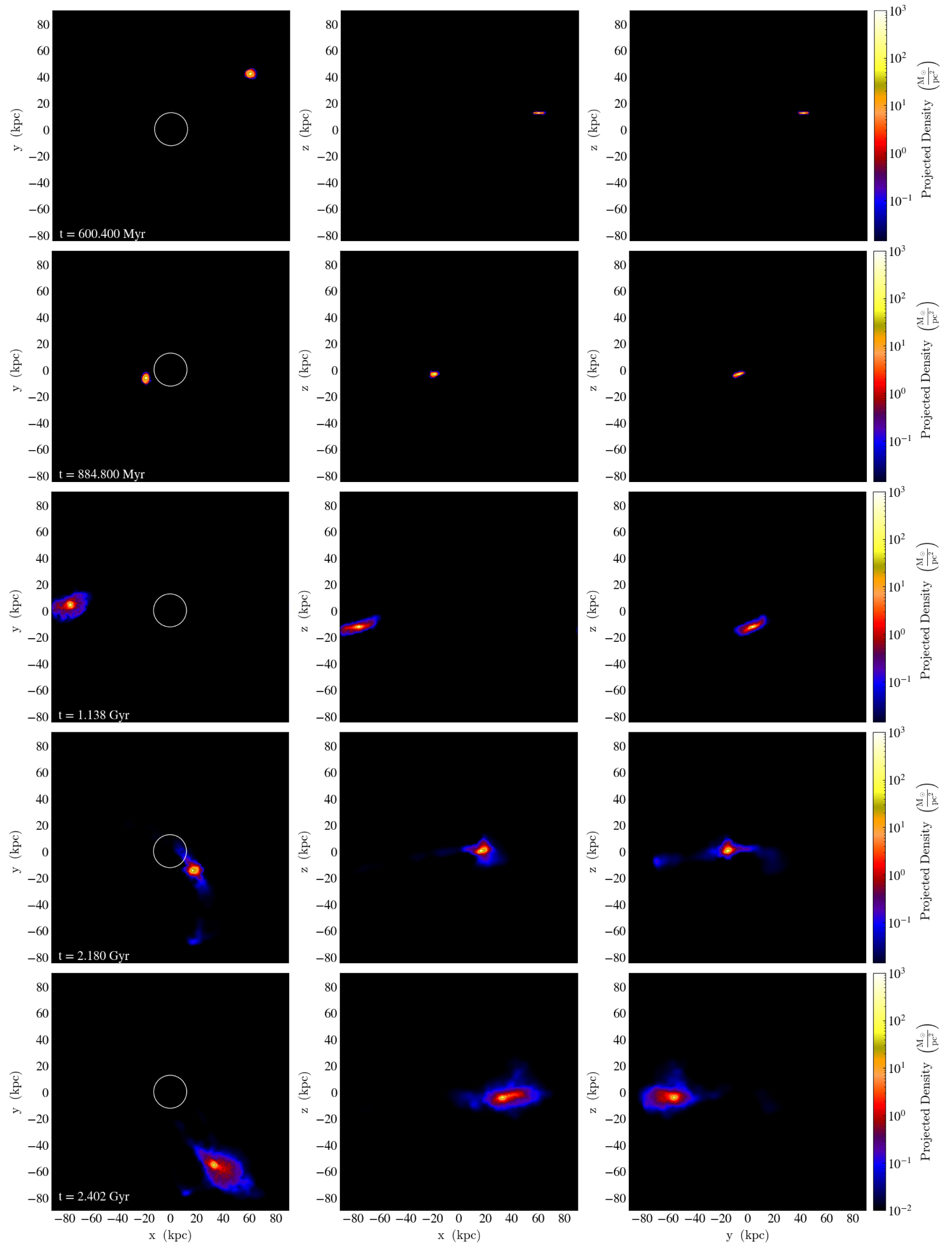

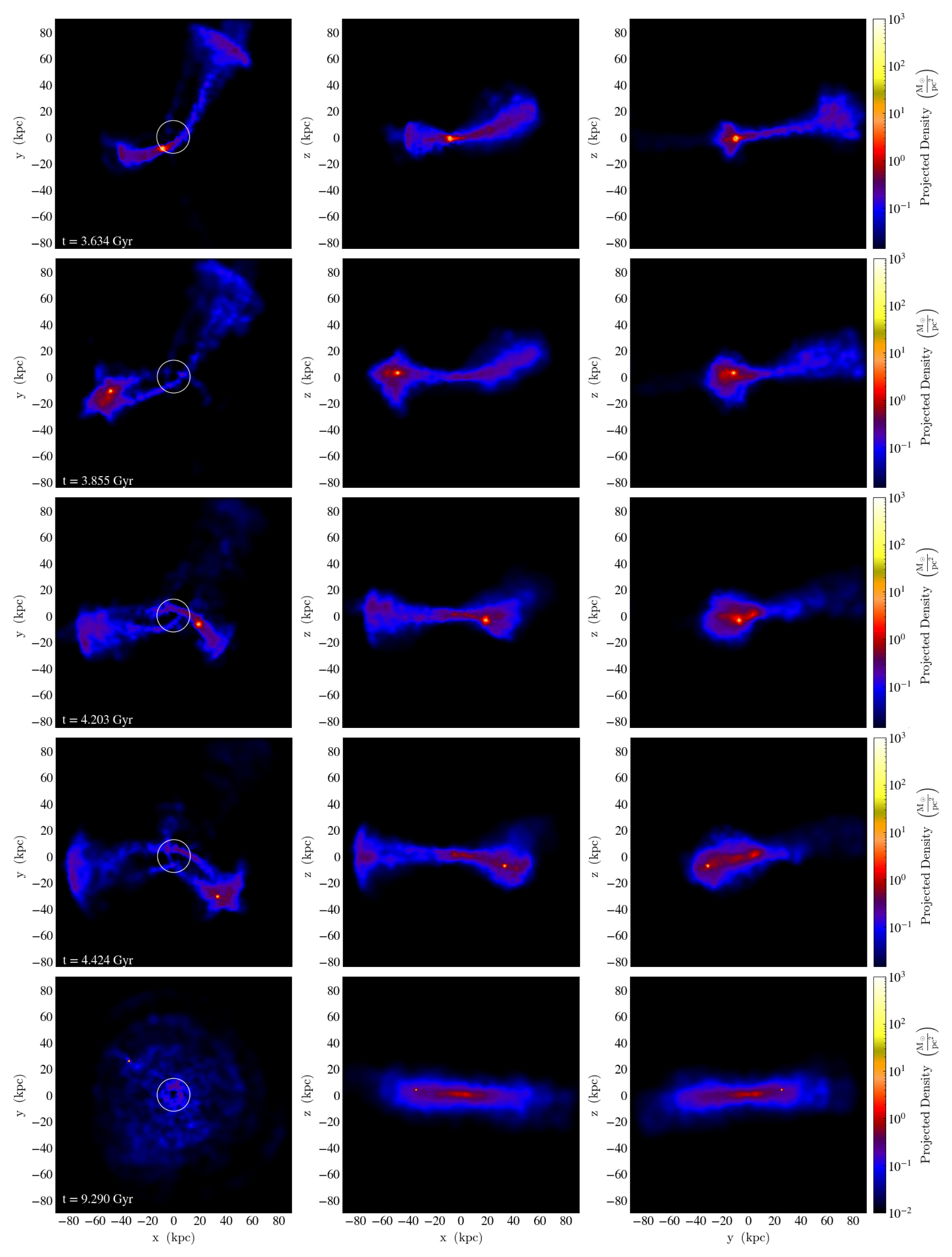
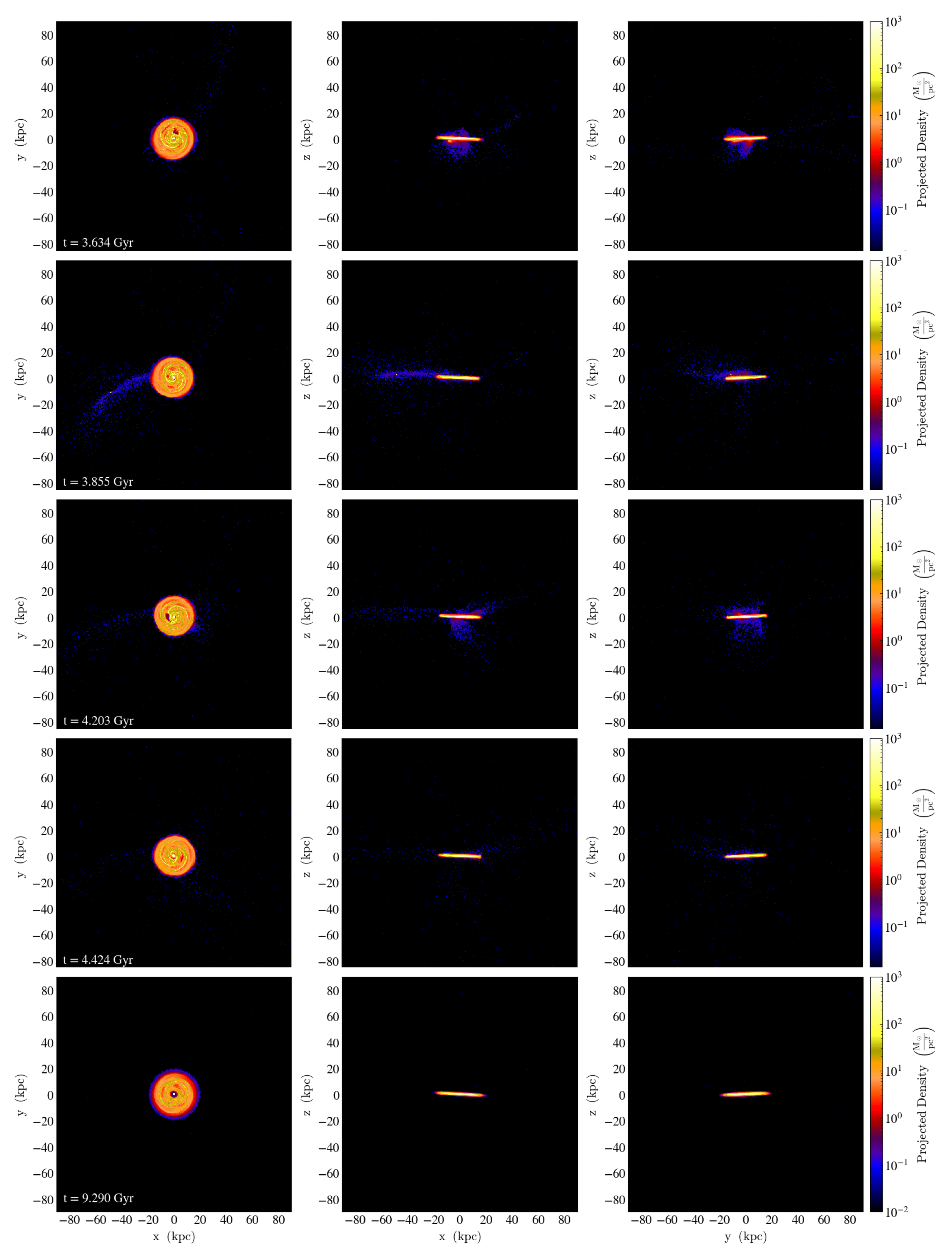


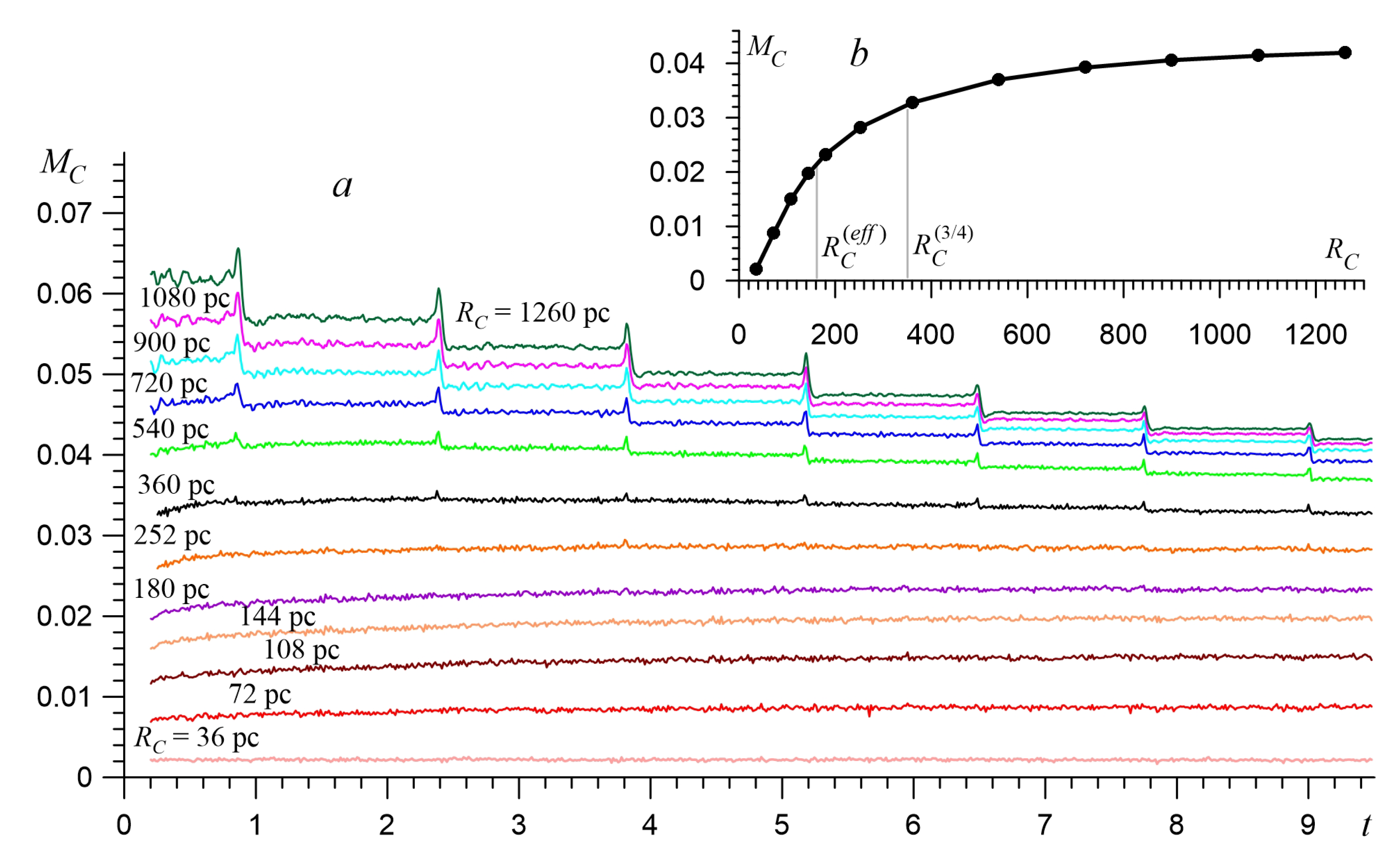
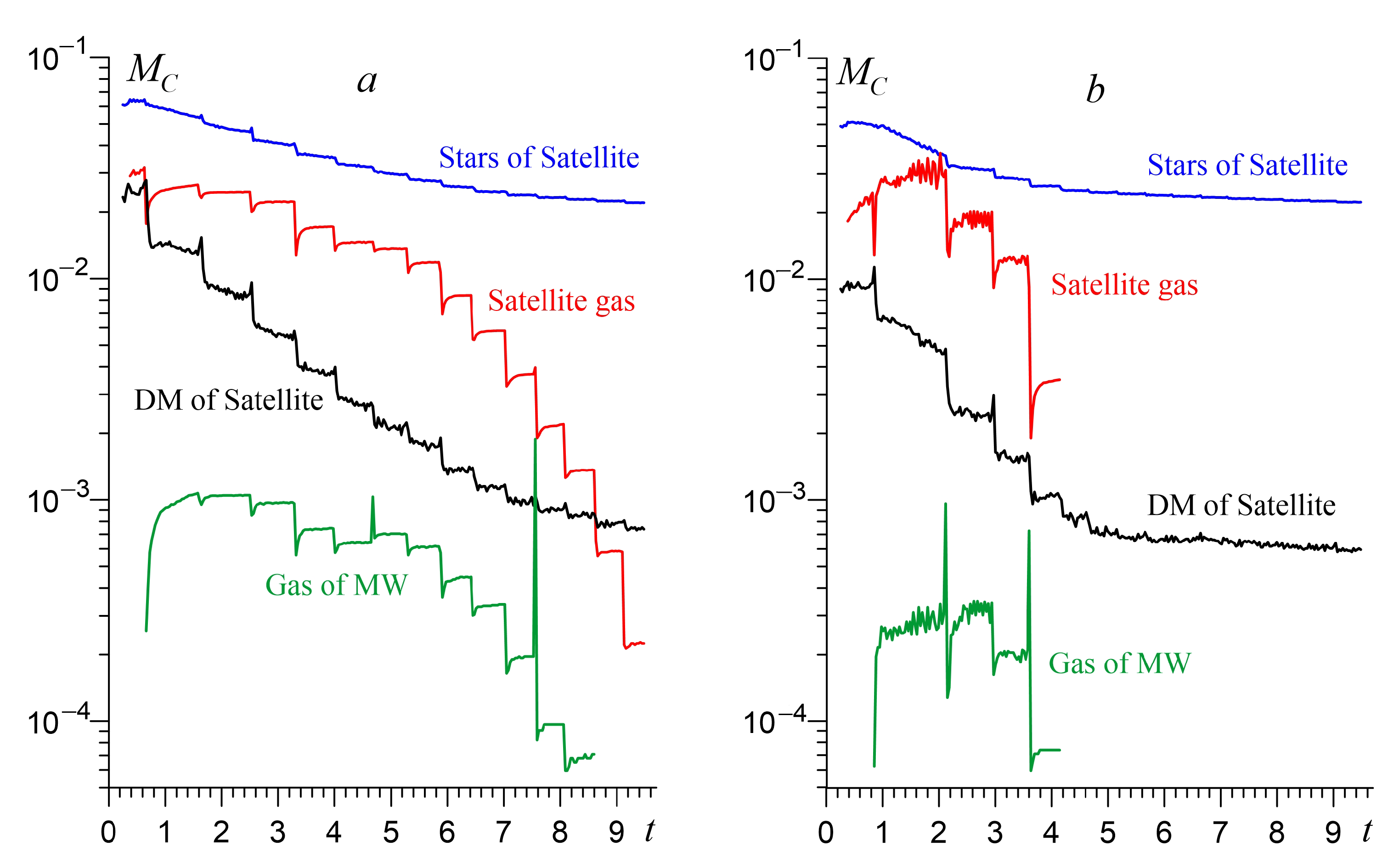
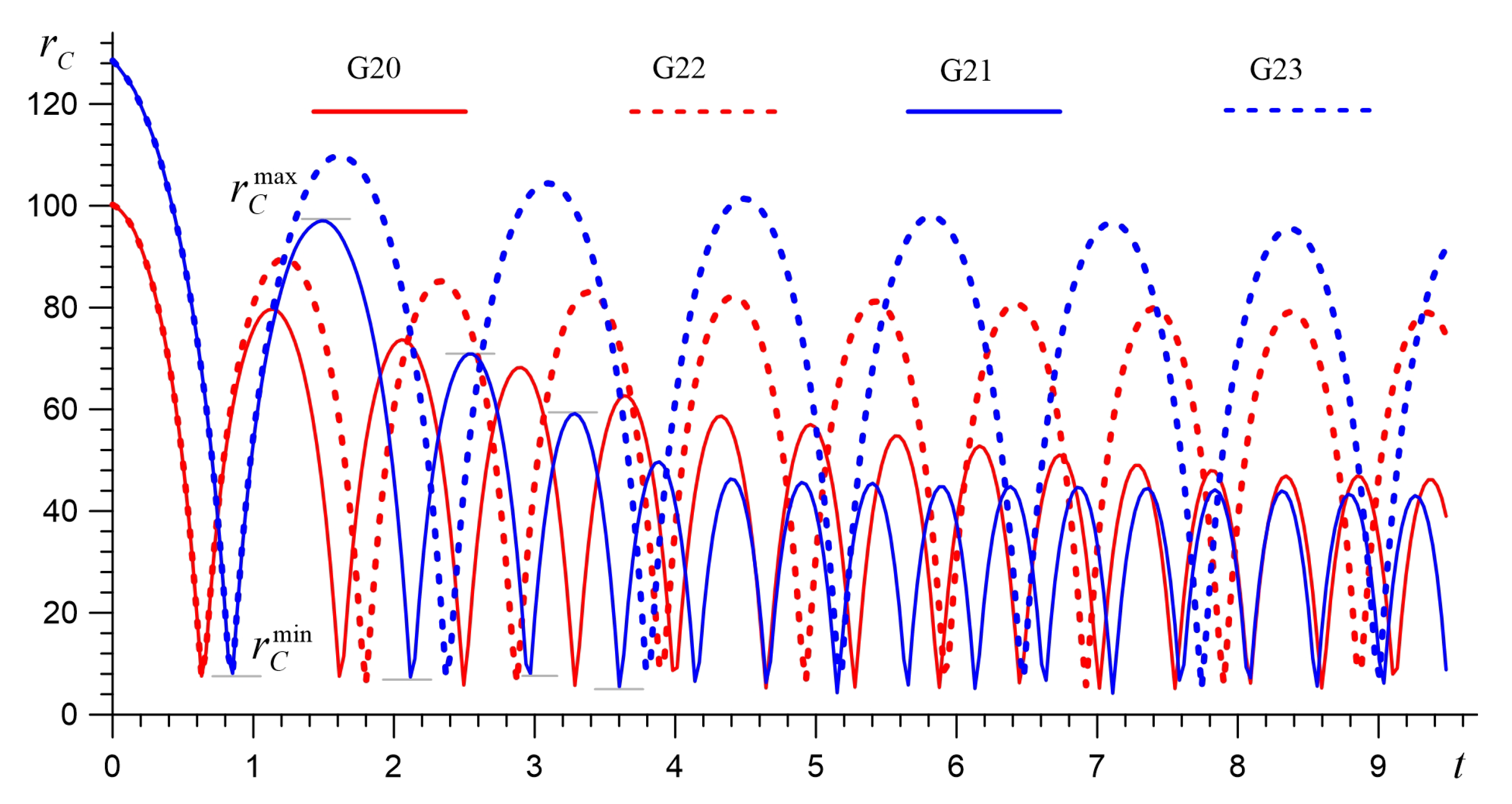
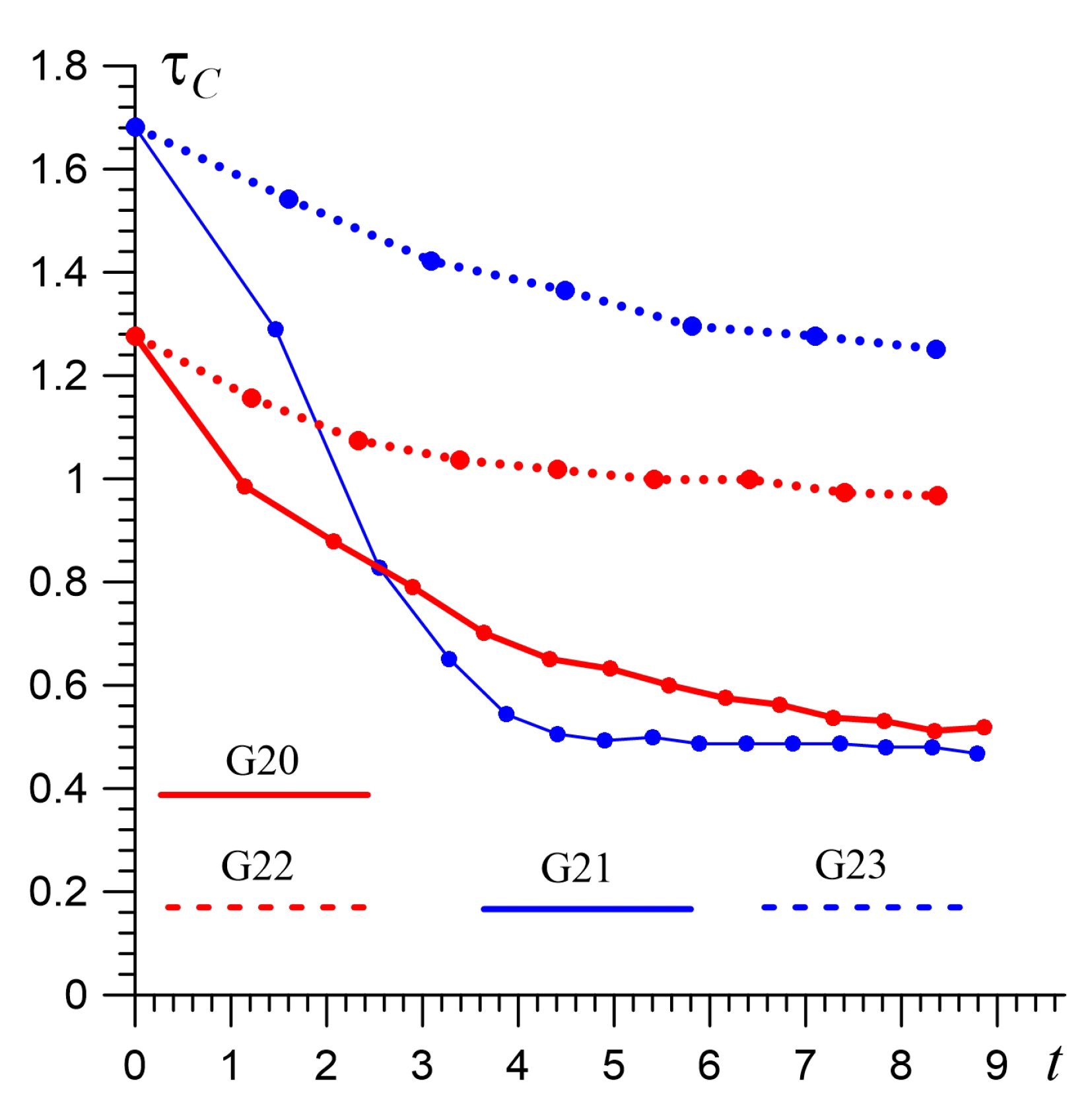
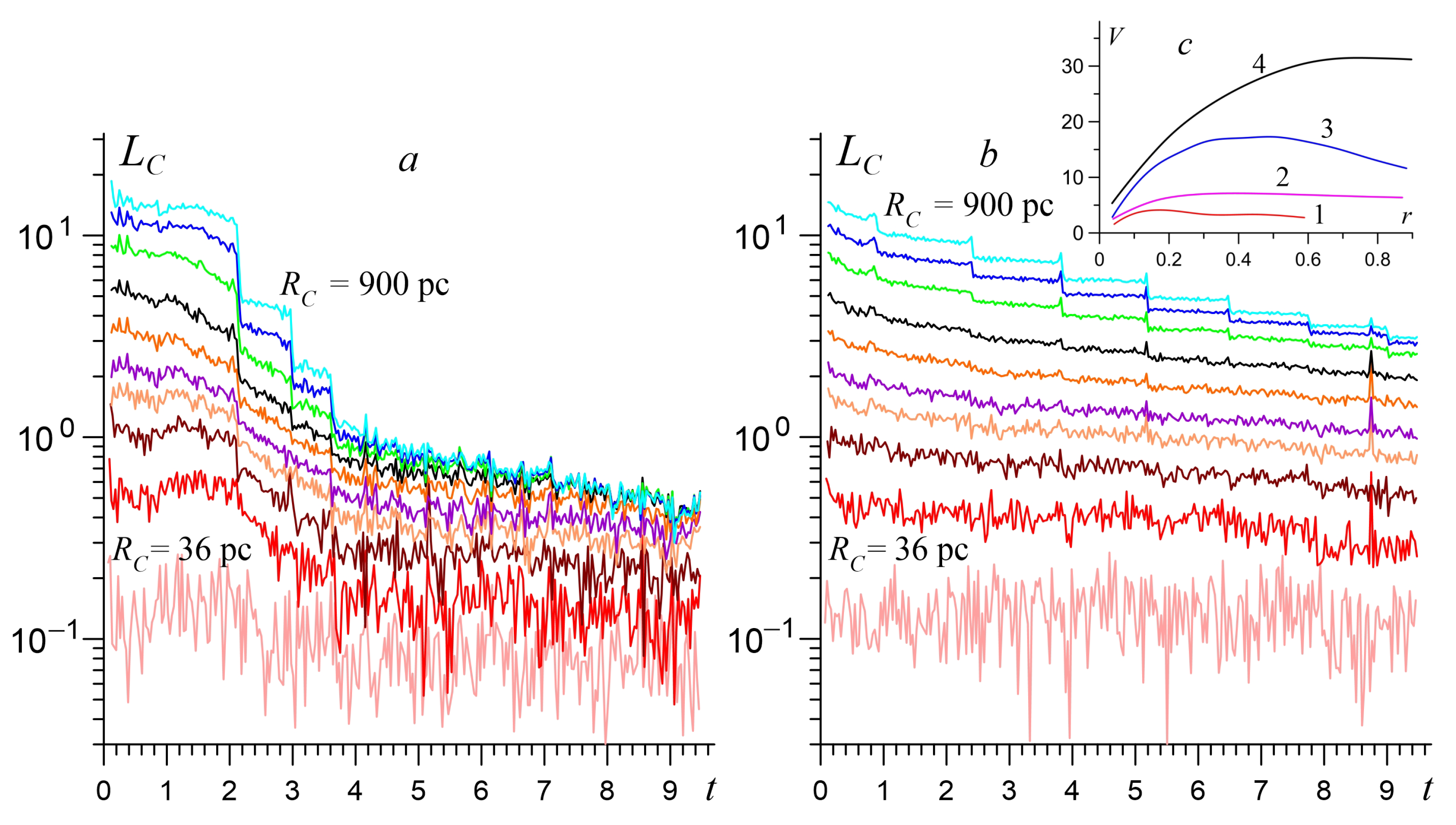
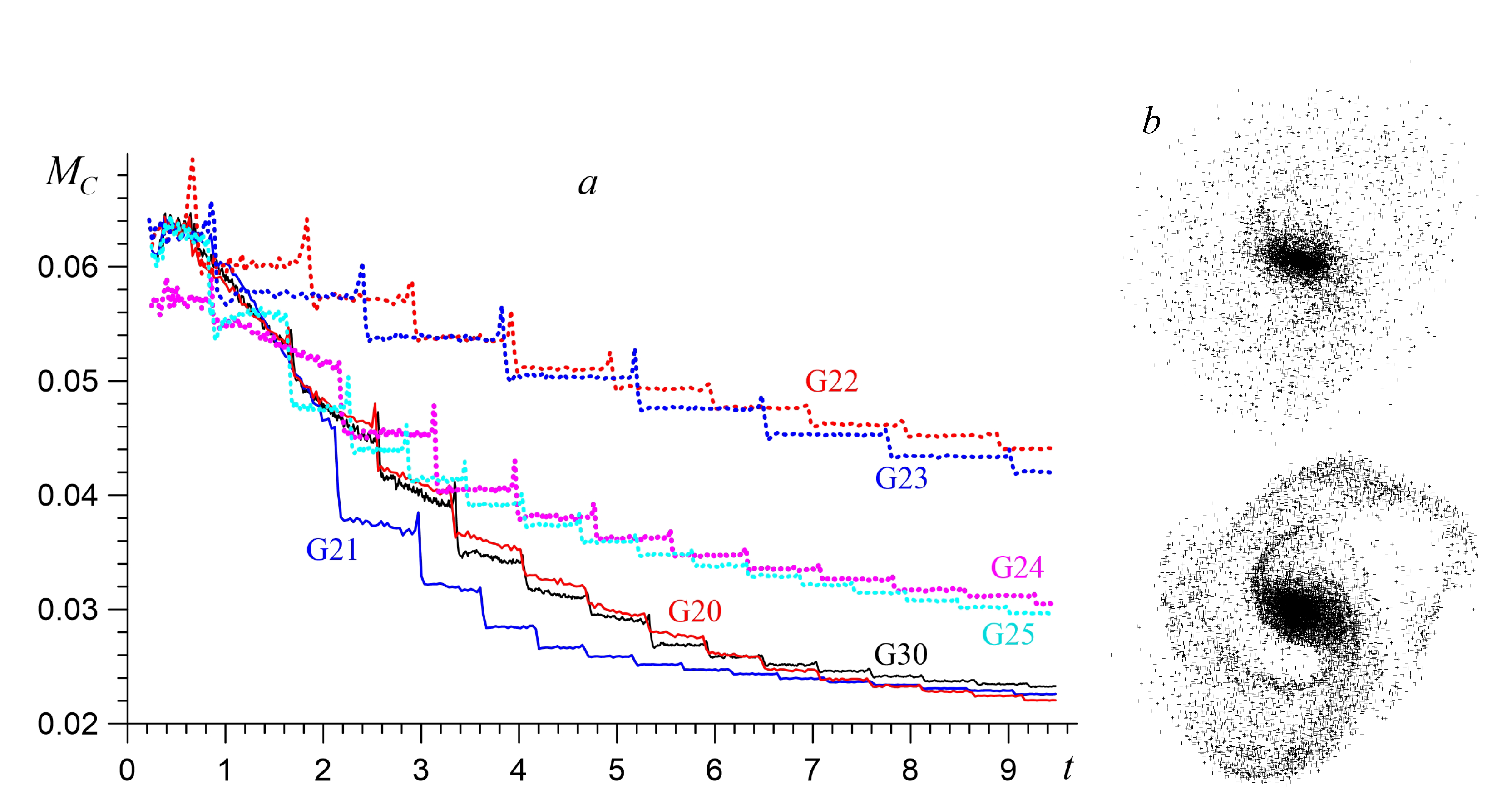
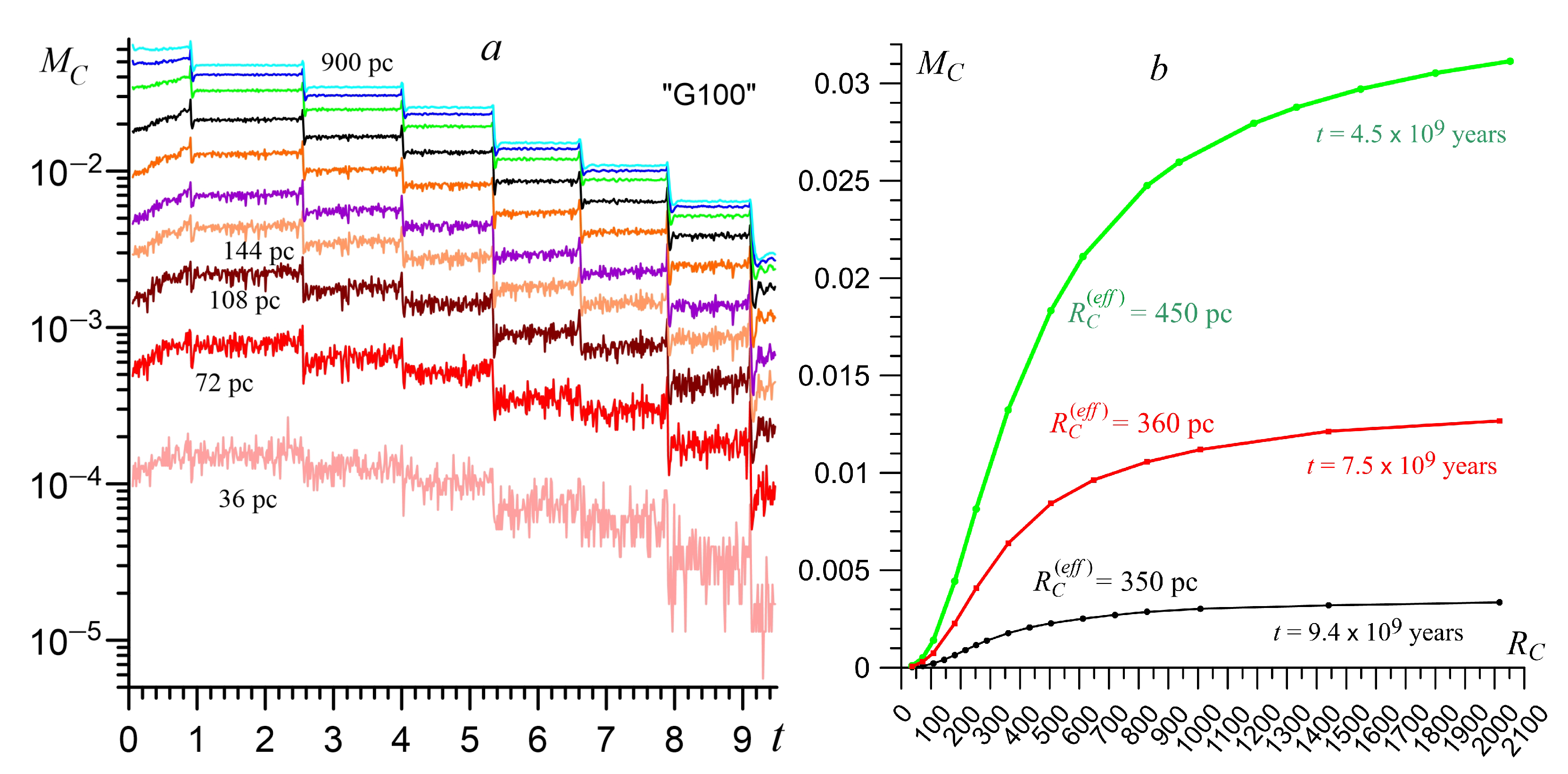
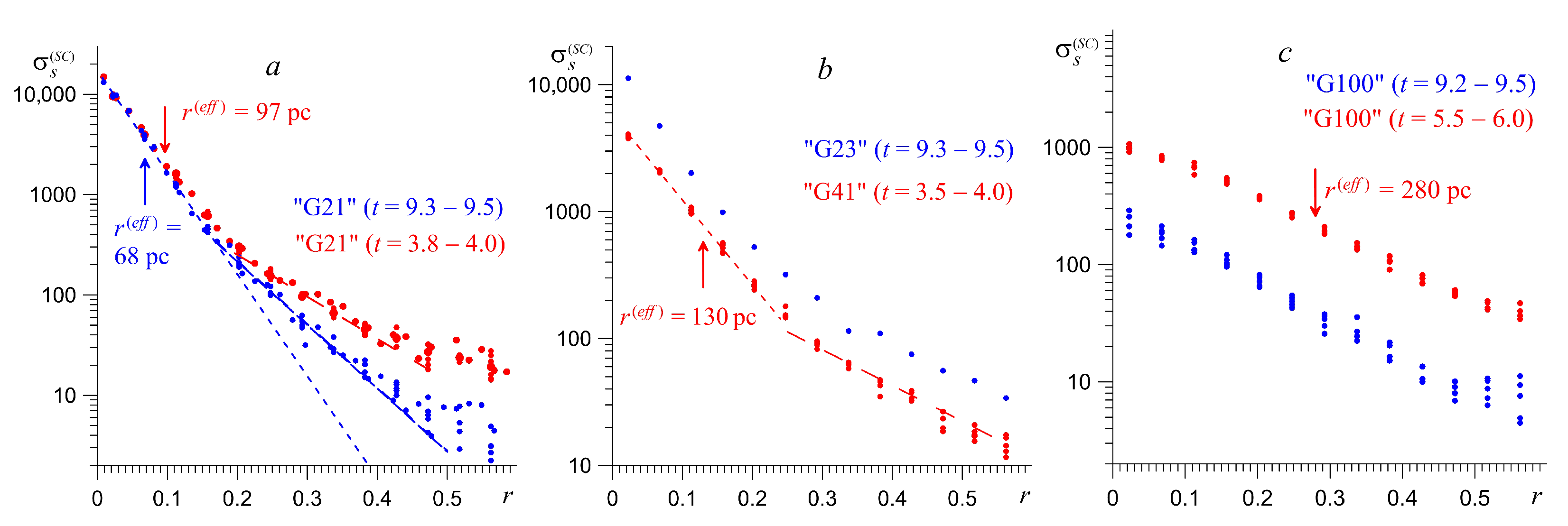
| Parameter | |
|---|---|
| Milky-Way model: | |
| Stellar mass in MW, | |
| Gas mass, | |
| Dark-halo mass, | |
| Bulge mass, | |
| Bulge scale, | 0.39 kpc |
| Radial scale of stellar disc, | kpc |
| Satellite model: | |
| Mass of stars in the satellite, | |
| Outer boundary of the stellar disc, | 2.7 kpc |
| Outer boundary of the gas disc | 3.5 kpc |
| Dark-halo mass, | |
| Initial azimuthal velocity, | km s |
| Initial radial velocity, | km s |
| Name | , | , | , | , | , |
|---|---|---|---|---|---|
| kpc | Degrees | Degrees | |||
| G20 | 0.093 | 0.093 | 100.4 | 70.7 | 0 |
| G21 | 0.093 | 0.093 | 128.5 | 11.3 | 0 |
| G22 | 0.093 | 0 | 100.4 | 70.7 | 0 |
| G23 | 0.093 | 0 | 128.5 | 11.3 | 0 |
| G24 | 0.093 | 0.0465 | 128.5 | 11.3 | 0 |
| G25 | 0.093 | 0.093 | 127.3 | 0 | 0 |
| G27 (Sph) | 0.093 | 0 | 128.5 | 11.3 | – |
| G28 (Sph) | 0.093 | 0 | 100.4 | 70.7 | – |
| G30 | 0.093 | 0.093 | 100.4 | 70.7 | 90 |
| G31 | 0.093 | 0.093 | 128.5 | 11.3 | 90 |
| G41 | 0.093 | 0.093 | 128.5 | 11.3 | 0 |
| G49 | 0.07 | 0.07 | 128.5 | 11.3 | 0 |
| G50 | 0.085 | 0.085 | 128.5 | 11.3 | 0 |
| G100 | 0.093 | 0 | 128.5 | 11.3 | 0 |
Disclaimer/Publisher’s Note: The statements, opinions and data contained in all publications are solely those of the individual author(s) and contributor(s) and not of MDPI and/or the editor(s). MDPI and/or the editor(s) disclaim responsibility for any injury to people or property resulting from any ideas, methods, instructions or products referred to in the content. |
© 2023 by the authors. Licensee MDPI, Basel, Switzerland. This article is an open access article distributed under the terms and conditions of the Creative Commons Attribution (CC BY) license (https://creativecommons.org/licenses/by/4.0/).
Share and Cite
Khoperskov, A.V.; Khrapov, S.S.; Sirotin, D.S. Formation of Transitional cE/UCD Galaxies through Massive/Dwarf Disc Galaxy Mergers. Galaxies 2024, 12, 1. https://doi.org/10.3390/galaxies12010001
Khoperskov AV, Khrapov SS, Sirotin DS. Formation of Transitional cE/UCD Galaxies through Massive/Dwarf Disc Galaxy Mergers. Galaxies. 2024; 12(1):1. https://doi.org/10.3390/galaxies12010001
Chicago/Turabian StyleKhoperskov, Alexander V., Sergey S. Khrapov, and Danila S. Sirotin. 2024. "Formation of Transitional cE/UCD Galaxies through Massive/Dwarf Disc Galaxy Mergers" Galaxies 12, no. 1: 1. https://doi.org/10.3390/galaxies12010001






